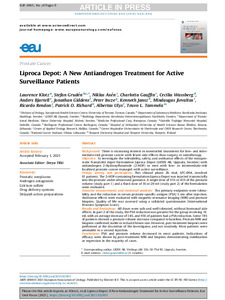Liproca Depot : A New Antiandrogen Treatment for Active Surveillance Patients
Klotz, Laurence; Grudén, Stefan; Axén, Niklas; Gauffin, Charlotta; Wassberg, Cecilia; Bjartell, Anders; Giddens, Jonathan; Incze, Peter; Jansz, Kenneth; Jievaltas, Mindaugas; Rendon, Ricardo; Richard, Patrick O; Ulys, Albertas; Tammela, Teuvo L (2022)
Klotz, Laurence
Grudén, Stefan
Axén, Niklas
Gauffin, Charlotta
Wassberg, Cecilia
Bjartell, Anders
Giddens, Jonathan
Incze, Peter
Jansz, Kenneth
Jievaltas, Mindaugas
Rendon, Ricardo
Richard, Patrick O
Ulys, Albertas
Tammela, Teuvo L
2022
Julkaisun pysyvä osoite on
https://urn.fi/URN:NBN:fi:tuni-202105054461
https://urn.fi/URN:NBN:fi:tuni-202105054461
Kuvaus
Peer reviewed
Tiivistelmä
BACKGROUND: There is increasing interest in nonmorbid treatments for low- and intermediate-risk prostate cancer with fewer side effects than surgery or radiotherapy. OBJECTIVE: To investigate the tolerability, safety, and antitumor effects of the intraprostatic NanoZolid depot formulation Liproca Depot (LIDDS AB, Uppsala, Sweden) with antiandrogen 2-hydroxyflutamide (2-HOF) in men with low- or intermediate-risk localized prostate cancer managed with active surveillance. DESIGN, SETTING, AND PARTICIPANTS: This clinical phase 2b trial, LPC-004, involved 61 patients. The 2-HOF-containing formulation Liproca Depot was injected transrectally into the prostate under ultrasound guidance. A single dose of 35% or 45% of the prostate volume (study part 1) and a fixed dose of 16 or 20 ml (study part 2) of the formulation were evaluated. OUTCOME MEASUREMENTS AND STATISTICAL ANALYSES: The primary endpoints were tolerability and the reduction in serum prostate-specific antigen (PSA) 5 mo after injection. Antitumor effects were evaluated with magnetic resonance imaging (MRI) and prostate biopsies. Quality of life was assessed using a validated questionnaire (International Prostate Symptom Score). RESULTS AND LIMITATIONS: All doses were safe and well tolerated, without hormonal side effects. In part 2 of the study, the PSA reduction was greatest for the group receiving 16 ml, with an average decrease of 14%, and 95% of patients had a PSA reduction. Some 78% of patients showed a prostate volume decrease compared to baseline. Prostate MRI and biopsies confirmed stable or reduced lesion size. However, post treatment biopsies were performed at the discretion of the investigator, and not routinely. Most patients were amenable to a second injection. CONCLUSIONS: PSA and prostate volume decreased in most patients. Indications of efficacy were shown by post-treatment MRI and biopsies demonstrating stabilization or regression in the majority of cases. PATIENT SUMMARY: Liproca Depot is a safe, minimally invasive treatment that offers the potential for cancer control in patients with intermediate-risk prostate cancer. Further clinical evaluation is warranted.
Kokoelmat
- TUNICRIS-julkaisut [16908]
